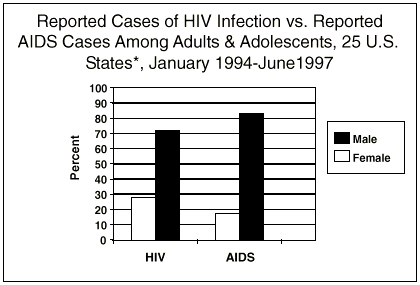
 |
Critical Need to Pay Attention to HIV Prevention for Women: Minority and Young Women Bear Greatest Burden June 1998
The CDC estimates that, in the United States, between 120,000 and 160,000 adult and
adolescent females are living with HIV infection. In just over a decade, the proportion
of all AIDS cases reported among adult and adolescent women nearly tripled, from 7%
in 1985 to 22% in 1997. HIV/AIDS was the fourth leading cause of death among U.S.
women aged 25-44 in 1996 (the most recent year for which complete death information
is available), and the leading cause of death among African-American women in this
same age group. Today, AIDS-related deaths among women are decreasing, largely as
a result of recent advances in HIV treatment. However, AIDS deaths among women
are not declining as rapidly as AIDS-related deaths among men.
Further, HIV data from a recent CDC study comparing HIV and AIDS diagnoses in
25 states(1) with integrated reporting systems showed that a substantial number of
women were newly diagnosed
with HIV in these states.
Between 1995 and 1996, there
was a 3% increase in initial HIV
diagnoses among women, while
HIV diagnoses declined 3%
among men during this same
period.
Epidemic Among Women Spreading Fastest Among Minorities
Over the past decade, the epidemic has increased most dramatically among women of
color. Prior to the impact of new combination drug therapies to treat HIV infection,
AIDS incidence was increasing at rates of 15% to 30% each year among African-American and Hispanic women. African-American and Hispanic women together
represent less than one-fourth of all U.S. women, yet they account for more than three-fourths (76%) of AIDS cases reported to date among women in our country.
Most women with AIDS were infected through heterosexual exposure to HIV, followed
by injection drug use. In addition to the direct risks associated with drug use (sharing
needles), drug use also is fueling the heterosexual spread of the epidemic. A large
proportion of women infected heterosexually were infected through sex with an
injection drug user. Reducing the toll of the epidemic among women will require
efforts to combat substance abuse, in addition to reducing HIV risk behaviors.
Female adolescents and young adult women under the age of 25 are at higher risk for
HIV/STD infection than older women. This increased risk is likely due to their greater
tendency to have multiple sex partners, to engage in risky behaviors, or to be unable to
negotiate safer sexual practices with partners.
Young and minority women are also disproportionately affected by other STDs -
gonorrhea, syphilis, and chlamydia, for example - that make women at least 2-5 times
more vulnerable to HIV infection. Improved STD treatment will be a critical strategy
for slowing the heterosexual spread of HIV.
Building Better Prevention Programs for Women
Even if women know how to protect themselves from HIV infection, awareness of the
facts must be coupled with the skills and support needed to change behavior. CDC
works with states and communities to provide the information and tools needed to
design and implement effective local prevention programs for women. To guide
prevention activities, CDC works to provide the best available science in the areas of
monitoring the epidemic, conducting and disseminating the findings from research, and
evaluating what works. As part of this process, CDC conducts an ongoing research
synthesis process that seeks to identify the most recent and relevant scientific findings
from around the world, both published and unpublished, and make them available to
prevention program planners. CDC constantly combs the scientific literature, reviews
domestic and international scientific databases, and speaks with colleagues around the
world to identify effective interventions for all populations at risk, including women.
Continuing progress is needed in the following areas to slow the HIV epidemic among
U.S. women:
Pay attention to prevention for women! The AIDS epidemic is far from over. Data
from states that have integrated confidential HIV and AIDS case reporting show that
a larger proportion of women are reported with HIV than are reported with AIDS.
Scientists believe that cases of HIV infection reported among 13- to 24-year-olds are
indicative of overall trends in HIV incidence (the number of new infections in a
given time period, usually a year) because this age group has more recently initiated
high-risk behaviors - and young women made up nearly half (44%) of HIV cases in this
age group.
1. Alabama, Arizona, Arkansas, Colorado, Idaho, Indiana,
Louisiana, Michigan, Minnesota, Mississippi, Missouri, Nevada, New Jersey, North Carolina,
North Dakota, Ohio, Oklahoma, South Carolina, South Dakota, Tennessee, Utah, Virginia,
West Virginia, Wisconsin, Wyoming  Comparing HIV to AIDS
diagnoses in these states
provides a clearer picture of
recent shifts in the epidemic,
with a larger percentage of
HIV than AIDS cases diagnosed
among women, especially
women of color. During the
period from January 1994
through June 1997, women
represented just 17% of all
AIDS diagnoses, but 28% of all HIV diagnoses. Young people (ages 13 to 24) also
accounted for a much greater proportion of HIV than AIDS diagnoses (14% versus 3%),
and nearly half of the HIV diagnoses in that age group were among young women.
Comparing HIV to AIDS
diagnoses in these states
provides a clearer picture of
recent shifts in the epidemic,
with a larger percentage of
HIV than AIDS cases diagnosed
among women, especially
women of color. During the
period from January 1994
through June 1997, women
represented just 17% of all
AIDS diagnoses, but 28% of all HIV diagnoses. Young people (ages 13 to 24) also
accounted for a much greater proportion of HIV than AIDS diagnoses (14% versus 3%),
and nearly half of the HIV diagnoses in that age group were among young women.
Last Update: July 24, 1998
Centers for Disease Control & Prevention
National Center for HIV, STD and TB Prevention
Division of HIV/AIDS Prevention
email: hivmail@cdc.gov
Go to the CDC Updates Menu
Go to the Women & Children Menu
Go to the HIVpositive.us Main Menu